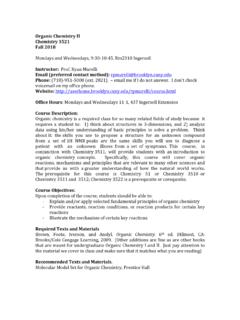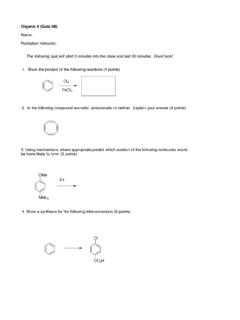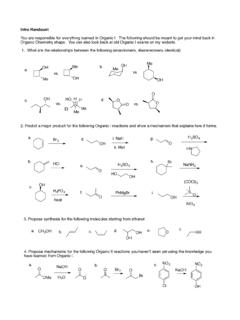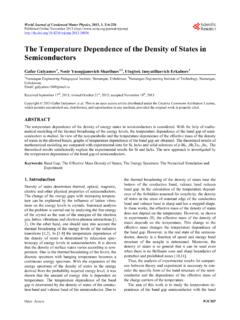Transcription of Temperature dependence of the band gap of perovskite ...
1 Temperature dependence of the band gap of perovskite semiconductorcompound CsSnI3 Chonglong Yu, Zhuo Chen, Jian J. Wang, William Pfenninger, Nemanja Vockic et al. Citation: J. Appl. Phys. 110, 063526 (2011); doi: View online: View Table of Contents: Published by the American Institute of Physics. Related ArticlesBand gap and electronic properties of wurtzite-structure ZnO co-doped with IIA and IIIA J. Appl. Phys. 110, 063724 (2011) Ferromagnetism in ZnO co-doped with Mn and N studied by soft x-ray magnetic circular dichroism Appl. Phys. Lett. 99, 132508 (2011) Single crystal strontium titanate surface and bulk modifications due to vacuum annealing J. Appl. Phys. 110, 064107 (2011) band structure properties of novel BxGa1xP alloys for silicon integration J.
2 Appl. Phys. 110, 063101 (2011) Electronic properties of vacancy related defects in ZnO induced by mechanical polishing Appl. Phys. Lett. 99, 112112 (2011) Additional information on J. Appl. Homepage: Journal Information: Top downloads: Information for Authors: Downloaded 13 Oct 2011 to Redistribution subject to AIP license or copyright; see dependence of the band gap of perovskite semiconductorcompound CsSnI3 Chonglong Yu,1,2 Zhuo Chen,1,2 Jian J. Wang,3 William Pfenninger,3 Nemanja Vockic,3 John T. Kenney,3and Kai Shum1,2,a)1 Department of Physics, Brooklyn College of the City University of New York 2900 Bedford Avenue, Brooklyn,New York 11210, USA2 Physics Program, Graduate Center of the City University of New York 365 Fifth Avenue, New York, New York10016, USA3 OmniPV, Inc.
3 , 1030 Hamilton Court, Menlo Park, California 94025, USA(Received 15 April 2011; accepted 8 August 2011; published online 27 September 2011)The Temperature dependence of the bandgap of perovskite semiconductor compound CsSnI3isdetermined by measuring excitonic emission at low photoexcitation in a Temperature range from9 to 300 K. The bandgap increases linearly as the lattice Temperature increases with a linearcoefficient of meV K 1. This behavior is distinctly different than that in most of tetrahedralsemiconductors. First-principles simulation is employed to predict the bandgap change with therigid change of lattice parameters under a quasi-harmonic approximation. It is justified thatthe thermal contribution dominates to the bandgap variation with Temperature , while the directcontribution of electron-phonon interaction is conjectured to be negligible likely due to the unusuallarge electron effective mass for this American Institute of Physics.
4 [ ]I. INTRODUCTIONCsSnI3belongs to the class of perovskite semiconduc-tors with the chemical formula of ABX3. It consists of a net-work of corner-sharing BX6octahedra, where the B atom isa metal cation, X is a monovalent anion, and A cation isincorporated to balance the total charge. The synthesis andcharacterization of CsSnI3have been described in our has been confirmed that CsSnI3compound in itsblack phase is a direct band -gap semiconductor with anenergy gap of eV. Additional steady state and time-resolved photoluminescence (PL) studies have shown thiscompound may have application potentials for high effi-ciency solar cells, solar luminescent concentrators, new lasermaterials, and other near-IR optoelectronic devices.
5 The na-ture of PL is determined to be excitonic, and the excitonbinding energy is deduced to be 18 large excitonbinding energy is due to the two-dimensional exciton motionin the layers of strong coupled of the interesting properties of CsSnI3is the strongand linear increase of the band (or energy) gap (Eg) withincreasing Temperature , which is opposite to what have beenobserved for most of common semiconductors . The elec-tronic bandgap is an important fundamental parameter of asemiconductor in terms of its electric and optical first experimental work on Egdated back to the dawn ofthe semiconductor era. The successes of semiconductorbased transistors, lasers, light-emitting diodes, and recentlysolar cells, have stimulated extensive works on the bandgapvariation with Temperature , Eg(T), both theoretically andexperimentally over many decades.
6 These studies have suc-cessfully explained the normal behavior of the temperaturedependence of bandgap: measured Eg(T) curves show amonotonic decrease with Temperature non-linearly at low Tand linearly at high T. However, there are some exceptions,which exhibit anomalous Temperature behaviors. An earlyexample is blue energy gap shift was reported forthis material in the Temperature range from 100 to 300 K. Inaddition, the measured band gaps of CuBr and CuCl increasemonotonically from near zero to room , a similar anomalous behavior has been observedfor reason for this anomalous bandgap behavior isnot quite clear yet and needs to be further new materials with an anomalous Temperature de-pendence of bandgap remains interesting and helpful forfully understanding this fundamental this paper, we report on the measured bandgap as afunction of Temperature in a potentially important semicon-ductor compound CsSnI3by PL method.
7 The bandgap isdetermined through a PL line shape analysis. It shows a line-arly positive relationship with Temperature from 20 to 300 explain our experimental data from three aspects. Wefirst revisit the theoretical background for the temperaturedependence of a semiconductor bandgap. We then study thedirect contribution of electron-phonon (e-p) , we determine the thermal contribution to thebandgap variation for CsSnI3by means of the EXPERIMENTPL experiments in this work were carried out by a Nano-Log apparatus from Horiba. It consists of a 450 W Xe lampas an excitation source, a double grating excitation spectrom-eter, a sample compartment with collection optics, ana)Author to whom correspondence should be addressed.
8 Electronic American Institute of Physics110, 063526-1 JOURNAL OF APPLIED PHYSICS110, 063526 (2011)Downloaded 13 Oct 2011 to Redistribution subject to AIP license or copyright; see spectrometer equipped with a Hamamatsu P2658 Rphotomultiplier tube. Analog signal is then fed to a singlephoton accounting electronics module for data acquisition. ACsSnI3thin film sample (silicon substrate in this case) wasmounted on the cupper finger of a closed-cycle optical cryo-stat, which is capable of having Temperature variation from 9to 350 K. Excitation wavelength was 500 nm with a pass- band of 5 nm. Excitation power density was about 20 mW/cm2. Spectra were corrected by using a standard light sourcepurchased from Ocean Optics PL spectra from 9 to 300 K are displayed The full width at half maximum (FWHM) of eachspectrum is shown in the inset of this figure.
9 Two importantfeatures are readily identified: (1) PL peak shifts to shorterwavelength and (2) PL spectrum broadens as the sampletemperature increases from 9 to 300 K. We now turn to dis-cuss how to deduce accurate band gaps from PL spectra atvarious sample temperatures . There are two contributions tothe PL linewidth broadening. One is the Temperature depend-ent asymmetric thermal broadening on the high energy tailof a spectrum arising from more energetic excitons. A con-stant two-dimensional density of states and a Boltzmannthermal distribution with an exciton Temperature (Tx) wereused for this part of line shape. The other one is due to thesymmetric broadening resulting from both the inhomogene-ous broadening because of the nature polycrystalline com-pound and the homogeneous broadening originated from theexciton scatterings with phonons and impurities.
10 Main rea-sons for inhomogeneous broadening may include composi-tion fluctuations and granular boundaries. We assume thissymmetric broadening to be a Gaussian with a variance the above two contributions, a PL spectrum at agiven sample Temperature can be fitted by the following con-volution expression:PL E GE;r exp E Eg Ebx =KBTx :(1)All measured PL spectra from 9 to 300 K were fitted byEq.(1). The calculated spectra are shown in (b).Todemonstrate the quality of fitting, two measured PL spectraat 80 and 220 K (discrete symbols) are plotted in anintensity-log scale in the inset along with the calculatedspectra (solid-line curves). The spectrum fit over three ordersof magnitude is highly satisfied for all spectra except a smalldeviation at low energy side for a few spectra with tempera-ture greater than 200 K.









![C = Q/ T = dQ/dT [J/deg] - University of Virginia](/cache/preview/a/f/5/8/1/b/f/3/thumb-af581bf37b8258665c1595c6c7b2f7a3.jpg)




